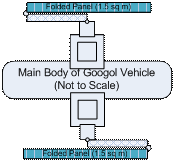energy conversion
Primary Energy Source
The second design consideration of the power system was determining the primary energy source. Compared to most satellites, the mission duration for Crescent Comm is very short at no longer than 3 weeks planned from launch to rover support conclusion. Therefore, power system options like nuclear reactors and radio isotope systems were quickly ruled out due to their extremely expensive cost and their primary applicability to interplanetary and deep-space missions. The mission was long enough to use a renewable energy source, because primary batteries alone would not supply enough power for 3 weeks without loading down the vehicle with hundreds of batteries.
Therefore, the solar PV-battery system was chosen and hence the Sun became our choice for the primary energy source. It provides a scalable amount of power with added solar panels while more than sufficing the mission duration requirements.
PV Energy Conversion
When choosing our solar cells, many factors had to be considered. However, our main focus was to decrease weight which would have the largest impact on the cost of the mission. Therefore, fewer very high efficiency solar panels were chosen over a higher number of lower efficiency panels.
We chose Spectrolab to manufacture the solar cells and panels. Not only are their solar cells specifically designed for the space environment, Spectrolab is the world leader in providing space-based solar arrays. Because the duration of the mission is relatively short, radiation degradation effects of the solar cells were not accounted for. At the expense of an increase in price to achieve a higher efficiency and thus decreased weight, Spectrolabís most efficient cells to date were chosen (28.3% beginning of life (BOL) efficiency): ultra triple junction (UTJ) GaInP2/GaAs/Ge solar cells. Several of these cells in series and parallel will create a solar panel.
From Patel’s Spacecraft Power Systems (2005), a good rule of thumb for determining the optimum system voltage is the following equation:
Optimum System Voltage = 0.025 * power requirement
Since our power requirement is >200 W, we should have an optimum system voltage of 5VDC. However, with this small of a voltage, the current will be relatively large and will increase the diameter requirement for the onboard conductors distributing the electricity. Therefore, the lowest common system spacecraft voltage of 28VDC was chosen for the Googol bus voltage.
Because 28V will be the bus voltage from which all accessories will run and the battery recharging circuits require a voltage greater than 28V, the voltage output of the solar panels should be slightly higher. The Voc of each solar panel should be 32 V to account for this. In addition the Isc of each panel should be 200W / 32V / 2 panels in parallel, which results in 3.125 A.
Spectrolab specifies a panel output of 330 W/m2 for these solar panels. If we assume a very conservative end of life (EOL) 24% efficiency with this configuration under Air Mass 0 conditions (1.353 kW/m2), and a poor sun incident angle of 40 degrees, this yields approximately 1 m2 of solar cells to maintain 212 W/m2. Therefore, we will order 2 panels at 1.5 m2 each to yield a maximum output at these conditions of 636 W/m2.
The solar array will consist of 2 wings that will be unfolded once the lunar landing has occurred. Alignment motors will rotate the solar panels to orthogonally align with the sun to produce maximum power. The following diagrams illustrate the wing in its folded and unfolded states. Slip rings inside the rotating mechanism will transfer the current from the solar panel to the PMAD system.

Figure illustrating solar panels folded
Figure illustrating solar panels fully extended